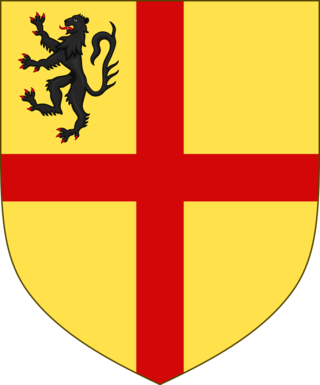Related Research Articles

Patrick Sarsfield, 1st Earl of Lucan was an Irish soldier and Jacobite. Killed at Landen in 1693 while serving in the French army, he is now best remembered as an Irish patriot and military hero.

The Treaty of Limerick, signed on 3 October 1691, ended the 1689 to 1691 Williamite War in Ireland, a conflict related to the 1688 to 1697 Nine Years' War. It consisted of two separate agreements, one with military terms of surrender, signed by commanders of a French expeditionary force and Irish Jacobites loyal to the exiled James II. Baron de Ginkell, leader of government forces in Ireland, signed on behalf of William III and his wife Mary II. It allowed Jacobite units to be transported to France, the diaspora known as the Flight of the Wild Geese.

Richard Talbot, 1st Earl of Tyrconnell, was an Irish politician, courtier and soldier.

Claud Hamilton, 4th Earl of Abercorn PC (Ire) (1659–1691) was a Scottish and Irish peer who fought for the Jacobites in the Williamite War. He went with King James to Derry in 1689 and tried to negotiate the surrender of the town with Adam Murray. He raised a regiment of horse that he led in the defeats of Newtownbutler in 1689 and Aughrim in 1691. He was killed when the ship that should have brought him to France was intercepted by a Dutch privateer.
Events from the year 1689 in Ireland.

Theobald Dillon, 7th Viscount Dillon of Costello-Gallin supported King James II, was attainted on 11 May 1691, and fell in the Battle of Aughrim during the Williamite War. His attainder was reversed in favour of the 8th Viscount on 20 June 1694.

Henry Dillon, 8th Viscount Dillon was an Irish soldier and politician. In 1689 he sat in the Patriot Parliament. He fought for the Jacobites during the Wiiliamite War, defending Galway against Ginkel and surrendering it in 1691 after a short siege. He obtained the reversal of his father's attainder in 1696 recovering his father's lands.
Arthur Dillon, Count Dillon (1670–1733) was a Jacobite soldier from Ireland who served as colonel of Dillon's Regiment in the Irish Brigade in French service. He fought in the Nine Years' War and in the War of the Spanish Succession where he excelled at the Battle of Cremona against Prince Eugene of Savoy.

Colonel William O'Brien, 7th Baron & 2nd Earl of Inchiquin, PC, was an Irish military officer, peer and colonial administrator who served as the governor of Tangier from 1675 to 1680 and the governor of Jamaica from 1690 until his death in office in 1692. O'Brien is best known for his long career in the service of the English Crown, serving as a colonial governor in England's overseas possessions in Africa and the West Indies.
Richard Burke, 6th Earl of Clanricarde was an Irish peer.

William Burke, 7th Earl of Clanricarde, PC (Ire), was an Irish peer who fought in his youth together with his brother Richard, 6th Earl of Clanricarde under their cousin, Ulick Burke, 1st Marquess of Clanricarde against the Parliamentarians in the Cromwellian conquest of Ireland. He succeeded his brother as the 7th Earl in 1666.

John Burke, 9th Earl of Clanricarde ; 1642–1722) was an Irish soldier and peer who was a colonel during the Williamite War in Ireland.

Colonel Thomas Butler of Garryricken, also known as Thomas Butler of Kilcash was an Irish Jacobite soldier. He commanded a regiment, Thomas Butler's foot, during the Williamite War and fought at the Battle of Aughrim in 1691 where he was taken captive. His son John would, de jure, become the 15th Earl of Ormond.
Sir William Talbot, 3rd BaronetPC (Ire) was the last of the Talbot baronets of Carton: his title was forfeited on account of his loyalty to King James II of England. He was an Irish politician and judge, who served briefly as Master of the Rolls in Ireland.

Honora Burke became Honora FitzJames, Duchess of Berwick on Tweed, married Patrick Sarsfield and went into French exile where he followed her soon afterwards. After his death at the Battle of Landen, she married James FitzJames, 1st Duke of Berwick, an illegitimate son of James II. She may have introduced the country dance to the French court.
Ulick Burke, 1st Viscount Galway was an Irish army officer slain at the Battle of Aughrim while fighting for the Jacobites during the Williamite War in Ireland.
Margaret Magennis, Viscountess Iveagh, also known as Margaret Butler, was the mother of John Butler, the de jure 15th Earl of Ormond. She is remembered by the song A Lament for Kilcash.
William Talbot of Ballynamony in County Wexford, also known as Wicked Will, was an Irish Jacobite. He represented Wexford Borough in the Patriot Parliament. He fought for James II during the Williamite War in Ireland at the Siege of Derry where he was wounded and captured. He died of his wounds while a prisoner in the besieged city.
James Talbot of Templeogue was an Irish Jacobite who served James II in the Irish Army during the War of the Two Kings (1689–91) and was killed at the Battle of Aughrim.
Hugh Montgomery, 2nd Earl of Mount Alexander was an Anglo-Irish soldier and peer.
References
- 1 2 3 4 5 6 7 Bergin, John (2009). "Moore, Garret". dib.ie. Dictionary of Irish Biography. Retrieved 24 September 2023.
- ↑ O'Hart, John (1892). "The Irish Parliament of King James the Second in 1689". Irish Pedigrees; or the Origin and Stem of the Irish Nation. Vol. 2 (5th ed.). Retrieved 24 September 2023.
- ↑ "MOORE, Garret. Colonel, 1690 in Mayo". Officers of the Jacobite Armies. Centre for Robert Burns Studies, University of Glasgow . Retrieved 24 September 2023.